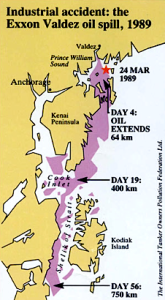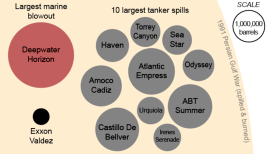Greatest Environmental Hazards From Arctic Drilling (Part 3)
October 23rd, 2014 by Sandy Dechert
(The story of the Kara Sea oil well, which went from being multinational to being solely operated by Russia, continued)
Now that the political dirt about arctic drilling is out of the way (Part 1 and Part 2 of this 3-part story), we’ll consider the threats from arctic drilling to the environment—the South Kara Sea between the Yamal Peninsula and Novaya Zemlya island.
Rosneft, the Russian oil drilling company in the ExxonMobil co-venture, tells us that “The sea is 40-350 meters deep with difficult ice conditions (ice-bound for 270-300 days a year). Winter temperatures plunge to minus 46˚С. Ice ranges in thickness from 1.2 to 1.6 meters.” So it’s cold, remote, dark, dangerous, and estimated to be twice as expensive to explore for oil and natural gas as other regions.
When the scientists tell us that the temps in the arctic are cold, that’s not such good news for arctic drilling. At least when Deepwater Horizon polluted the Gulf of Mexico with 4-5 million barrels of oil, bioremediation could go more swiftly because the water was warm.
 “If a spill of the magnitude of the one we saw in the Gulf of Mexico a few years ago happened in the Arctic,” said Jason Selwyn in Speak Up For Blue last year, “it would take many decades for the ecosystem to recover, possibly longer. This on top of the increased risk of a spill occurring due to the unforeseeable and generally harsher conditions associated with the Arctic that would impede any efforts to contain one should it occur.”
“If a spill of the magnitude of the one we saw in the Gulf of Mexico a few years ago happened in the Arctic,” said Jason Selwyn in Speak Up For Blue last year, “it would take many decades for the ecosystem to recover, possibly longer. This on top of the increased risk of a spill occurring due to the unforeseeable and generally harsher conditions associated with the Arctic that would impede any efforts to contain one should it occur.”
The remnants of the Exxon Valdez tanker spill (only a fifth of the DH amount) in Prince William Sound, Alaska, about 25 years ago are not only still evident: they also still need research and remediation.
The graphic below presents some of the long-lasting species and habitat effects of that Exxon spill on the Gulf of Alaska—which is a bit warmer than waters above the Arctic Circle.
In ice-free water, oil produced from a well can be offloaded onto a ship and transported to refineries. Pipelines are hardly an option. Natural gas, also present in the Arctic in high volumes, is even harder to transport than oil because it has to be supercooled into a liquid to be moved. That’s why the current emphasis is on oil—though when the oil is gone, natural gas will become the next hydrocarbon target.
 As noted above, the water of the Kara Sea is only ice-free for two or three months a year. Sea ice causes problems the rest of the year. It can damage offshore facilities and also restrict movement of personnel, materials, equipment, and oil.
As noted above, the water of the Kara Sea is only ice-free for two or three months a year. Sea ice causes problems the rest of the year. It can damage offshore facilities and also restrict movement of personnel, materials, equipment, and oil.
Frigid air and water temperatures and harsh winter weather necessitate specially designed and protected drilling equipment and human habitat. Such rigs are custom-engineered, making rescue by drilling a second hole (as in the Gulf of Mexico) extremely difficult, if possible at all with the equipment available. Supply lines are long and onshore transportation through marshy tundra is difficult, making spare parts and backup machinery necessary.
Not only is the likelihood of an arctic drilling oil spill much greater in the inhospitable environment, the spilled oil is more difficult to detect, track, reach, and respond to because of the ice. As for containment and recovery, ice defies conventional boom and skimmer systems. Another alternative is using dispersants, which can lessen oil impacts but also cause chemical and physical disturbances.
 So why are humans spending billions to continue our dependence on a resource that is geologically limited, creates terrible poisons, and encourages strife and war among nations (thus letting loose even more greenhouse gases)? We have other choices now. They include solar, wind, and other renewables. Obstructing their development could be considered tantamount to global treason.
So why are humans spending billions to continue our dependence on a resource that is geologically limited, creates terrible poisons, and encourages strife and war among nations (thus letting loose even more greenhouse gases)? We have other choices now. They include solar, wind, and other renewables. Obstructing their development could be considered tantamount to global treason.
Keep up to date with all the most interesting green news on the planet by subscribing to our (free) Planetsave newsletter.

Comments